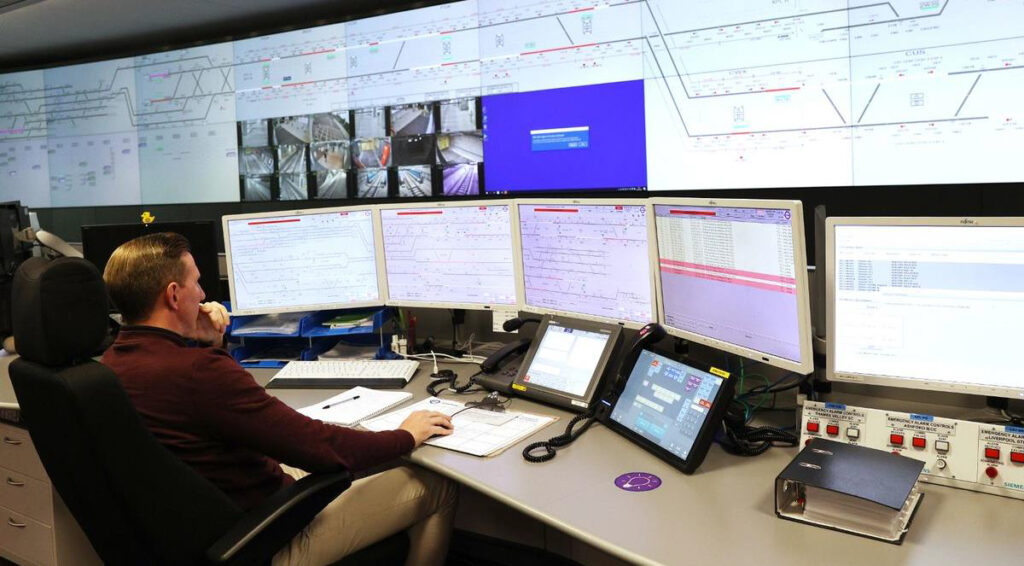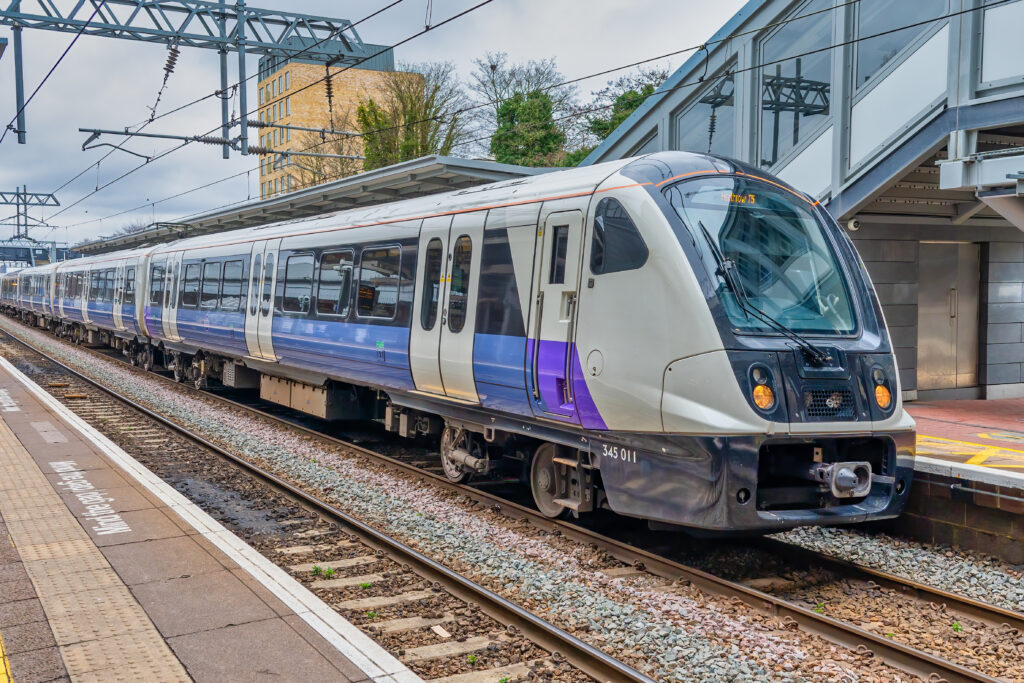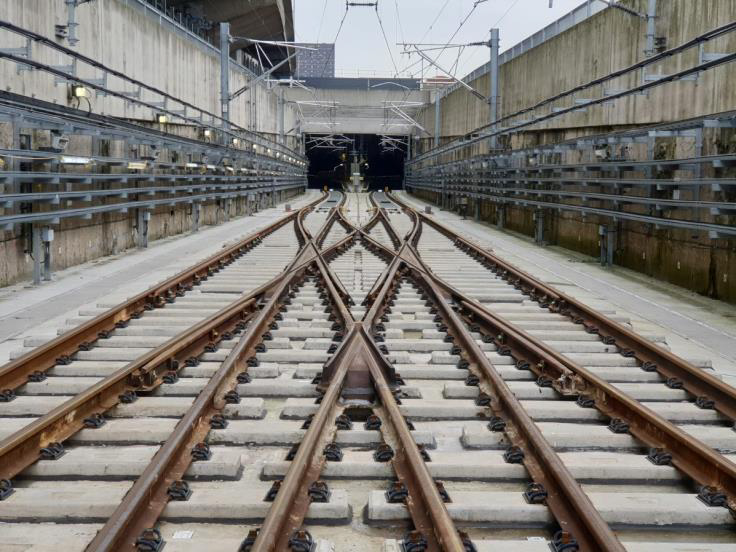Since the new cross London Elizabeth line opened in May 2022 (the project known as Crossrail), ridership has exceeded expectations. When travelling on one of its trains especially in peak hours, one might wonder where all the people come from and how did they get to places before. The trains and the stations are very impressive and easy to access. With nine carriages, if you are on the wrong end of the train to where the exit is, it might seem as if you have walked part of the journey!
Interesting that after all the debate as to delays to the programme and cost overruns, these things get quickly forgotten once the service is up and running. Such is the measure of success. How, therefore is the railway controlled and how are the operations managed on a daily basis? A visit to the Romford control centre with the IRSE International Technical Committee in May revealed all, with the added advantage that it could showcase the system to the wider world.
Elizabeth line route
As many readers will already know, the Elizabeth line extends from Reading and Heathrow Airport in the west to Shenfield and Abbey Wood in the east and south east. The central section from Paddington to Whitechapel and beyond to Abbey Wood is in brand new tunnels, with the line linking into existing routes westwards from Paddington and eastwards from Liverpool Street. The central section has 10 new stations, all of which interchange with other lines either operated by London Underground, London Overground, or Docklands Light Railway. At Farringdon, the line crosses the north south Thameslink route making for easy interchange between the two cross-London main line rail routes. All underground stations are fitted with platform screen doors (PSDs). On the Abbey Wood line, the stations at Custom House and Abbey Wood are on the surface and are not fitted with PSDs.
The central section tunnels have 12 cross passages for passenger evacuation in an emergency, these being accessed by doors to regulate the air flow and to comply with modern safety standards. A further underground section on the Abbey Wood line utilises the old double track Connaught tunnel that was once part of the original North London line to North Woolwich. This has been extensively refurbished to prevent water ingress from the old London dock areas above it.
From Westbourne Park in the west , the line shares tracks and services with the Great Western services to Reading and beyond, and from Stratford in the east, the line shares tracks with the Liverpool Street services out to Shenfield and Norwich. The basic service pattern is Shenfield to Paddington, Shenfield to Heathrow Terminal 5, Abbey Wood to Reading, Abbey Wood to Heathrow Terminal 4. The service offering at the time of the visit was 22 trains per hour (tph) in the peak but with the May timetable change this has increased to 24tph. Off peak the service reduces to 16tph.
To complement these, a stopping service from Romford to Liverpool Street main station remains and there are also local services from Reading to Paddington main line. The trains are the Class 345, each of nine cars, and there are 70 of them. Trains are stabled at Reading, Ilford, and Plumstead sidings where cleaning and maintenance is carried out.

Controlling the line
The central core section of the Elizabeth line has its own control room located within the Romford Railway Control Centre (ROC), so explained Gavin Hunter, the Network Operations Manager. The control room covers all rail functions and not just the signalling. The centre is staffed around the clock with three-shift working. Crucial functions are: incident response team; information co-ordinators; traffic managers; and real time infrastructure managers. Under the umbrella of the traffic manager, work stations are included for the control of signalling, power and ventilation.
Particularly important is the ventilation system which works on the pull and push of air. The purpose is to maintain air temperatures, manage direction and flow of any smoke emergency, and provide good air quality. There are 44 ventilation sections and only two trains are permitted in any one section. Should a section fail, then it can be combined with an adjacent section to create a longer section but still limiting operation to two trains in that section. The ventilation is very powerful and can sweep a person of their feet, so any entry to the tunnel or shafts has to be under controlled conditions. The platform screen doors are provided partly for safety reasons but also to help control the flow of air.
The control room operates as the security and information provider. Banks of TV screens show real time images of station platforms and passageways which can focus in on a particular position if an alarm is generated. Passenger information screens throughout the whole Elizabeth line route are automatic being driven from the signalling system in the central core and by timetable and train describers on the east and west above ground routes.
The signalling system
The signalling control of the line is complex because of the interfaces to other signalling types at both the west and east end of the central section, as explained by Andy Heath, the Signal and Control Engineer. For the central core, the signalling system is the Siemens Mobility Trainguard Mass Transit (TMT), one of the many proprietary systems available under the Communications Based Train Control (CBTC) banner. This includes the provision of moving block thus facilitating trains to be operated closer together at peak times.
The system is designed for GoA2 (Grade of Automation) which embraces automatic train operation (ATO) but retaining a driver in the front cab, primarily for door control and initiating the start from stations. The signalling is essentially hands off and is timetable driven. The latter includes GoA3 reversing moves at Paddington and Abbey Wood which are fully automatic as are all entries into and out of a depot. The line uses axle counters for secondary train positioning information other than where neutral sections for the overhead power exist, where track circuits are deployed, these being seen as less vulnerable to any spark interference from the overhead catenaries.
The central core lines are bi-direction signalled, but the facility is only used in an emergency such as a train becoming failed whence following trains would need to reverse. Since the Elizabeth line shares tracks with Network Rail at the western and eastern extremities, the train descriptions have to conform to the alpha numeric train identification standard used throughout the country. Unlike other metro systems overseas, this is not ideal as the trains cannot keep their same head code over a 24-hour period, there not being enough codes available for this. Every journey as such has to have a new description.
Radio communications throughout the central core is provided primarily by WiFi at 2.4GHz using tunnel mounted aerials but GSM-R is also provided. The WiFi communication is fine in the tunnel sections but has had some problems at Stratford owing to the proliferation of other WiFi signals in this area.
The complexity comes from the interfaces to other signalling systems beyond the central core. Westwards from Paddington, transition has to be made to TPWS / AWS for the onward journey to Reading and also to ETCS Level 2 out towards Airport Junction for the line to the Heathrow terminals. Eastwards is simpler as the transition at Stratford is only to TPWS / AWS for the journey to Shenfield.
The means of achieving these transitions automatically was described in Rail Engineer Issue 175 (June 2019) and readers keen to understand the precise process should refer to this. In summary, a train coming eastwards from the GW main line encounters two sets of balise groups. These will order the CBTC to ‘get ready’ and to prevent any train not fitted with CBTC to be stopped before entering the tunnel section. Driver prompts are given on the DMI (Driver Machine Interface) which if not acknowledged will cause the train to stop. A train exiting from Paddington and travelling westwards will have the CBTC inhibited once the first GW signal has been passed.
A similar process is in place for the east end transition where trains change from CBTC to TPWS / AWS and vice versa. In addition, to cater for any CBTC failure in the central core, ETCS Level 0 is the fall back system which a driver can call up at any time. This involves manual driving but with a reduced speed limit enforced. At the transition points, if calling for CBTC operation fails, then the second choice will be ETCS Level 0 and the train can proceed. It should be noted that the driver’s DMI when in CBTC mode includes information on station dwell time count down and platform screen door status.

After extensive testing, these transitions have worked well and so far, since entering passenger service few real problems have emerged. At the western end boundary at Westbourne Park, the route is controlled from the Thames Valley signalling centre at Didcot and at the eastern end at Pudding Mill Lane, although Romford ROC is operational, the signalling remains under the control of Liverpool Street Integrated Electronic Control Centre (IECC). In due course this will transfer to Romford.
Train fitment
With the multiplicity of signalling systems, all these have to be accommodated on the train. The cab DMI has been designed to combine all systems into a single display, viz TPWS / AWS, ETCS L2 and CBTC. The TPWS / AWS readers are mounted on the train bogies and the balise reader for CBTC is bolted to the underframe. Changing over between systems will be by prompts given to the driver (as indicated above) and the display will change to the new ongoing signalling system. The CBTC signals are transmitted to and from the train using the WiFi whilst the ETCS information is conveyed by the GSM-R radio.
Automatic reversing
At the locations where trains terminate, automatic reversal moves or change of driving cabs is facilitated. The most complex of these is at Paddington where trains arriving from the Liverpool Street direction, after having disgorged their passengers, enter into a turn back siding, stop, and then change direction to enter out into the eastbound platform. All of this is achieved automatically, leaving the driver to walk down the train to the far end cab whilst the reversing is under way. One complication in the procedure is the train description. The incoming head code is cancelled once the train has terminated. It is then allocated an empty stock code for the reversing process and, once in the platform, the new journey code is allocated to the train. Just one of the complications of the alpha numeric system.
Should a train have to stop short of its intended destination because of late running or an emergency, a new timetable and train description has to be created for the reversal move. This takes time and is made worse by the limitations of the alpha numeric allocations. Ways of improving the procedure are being investigated.
Electrification and power
The Elizabeth line is 25kV overhead line throughout the route using a 50kV auto-transformer feeding configuration powered principally from a feeder station at Pudding Mill Lane near Stratford, with alternatives feeds from Kensal Green and Stepney Green being available. In the central tunnel section, a Rigid Overhead Conductor (ROC) is used instead of a catenary, the primary reason for this being management of limited clearance. The ROC has given such good performance that it has proved possible to double the period between maintenance inspections as a result of operational experience. Neutral sections exist at Westbourne Park and Pudding Mill Lane, the locations where trains exit into the above ground routes.
For non-traction power, an 11kV and 22kV power ring is installed to supply all the station facilities including platform screen doors, ventilation, fire detection, telecoms and SCADA, emergency lighting, lifts and escalators, and drainage.
Maintenance and possessions
Unlike London Underground, the Elizabeth line has no allocated engineering hours. All access to the track, overhead line, and signalling system is carried out by arranging possessions, which are applied for in the normal way. Most long possessions will take place at night, but these have to be timed to take account of last and first train times.
It is however possible to take very short possessions during operating hours. A typical situation is someone dropping a mobile phone that then bounces on to the track. The station staff are equipped with a portable device (in essence a robust laptop) that can replicate a map issued from the control room operator. Once the possession is agreed, the location of it and the duration are shown on the screen which is identical to what the controller is seeing. During this time, the CBTC is essentially ‘switched off’ and train movements on that part of the line are stopped. The dropped item can then be recovered and the possession given up.
Longer engineering possessions also use the same portable device that enables greater working time to be achieved. For the present, complimentary paperwork is also required to be completed but this is intended to be simplified in due course.

In summary
That the Elizabeth line has made a difference to the daily commuting routines of many people is beyond doubt. It has also opened up new travel opportunities for visitors and tourists alike with the connection to Heathrow airport being particularly important. There are calls for the line to be extended beyond Abbey Wood to Dartford and Ebbsfleet but this will be challenging. The trains are not equipped for 750v third rail operation, so either they would have to be adapted to operate on DC traction with associated shoe gear or the line would need to be dual electrified with both 25kV overhead catenaries and third rail. Both options would be expensive. There is a connection at Abbey Wood but is only used for engineering trains or stock movements.
Although the Crossrail project ran late and over budget, its ultimate success might just be the trigger for renewed interest in Crossrail 2 that would run from Southwest to Northeast London and interconnect with lines in those areas. Having built one, it is to be hoped that lessons would be learned for the planned new line.
Image credit: TfL

